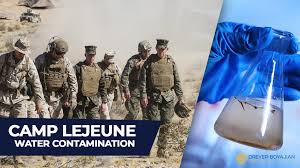Introduction
The Camp Lejeune lawsuit continues to be one of the most significant legal battles in recent U.S. history, rooted in decades of water contamination at a North Carolina military base. As thousands of affected individuals seek justice, the legal landscape has rapidly evolved. With new legislation, ongoing court proceedings, and an influx of compensation claims, 2025 marks a critical point in the Camp Lejeune legal timeline. This guide provides the most up-to-date and in-depth information on the Camp Lejeune lawsuit, helping victims and families understand their rights, eligibility, and compensation options.
Camp Lejeune Water Contamination – A Quick Recap
Between 1953 and 1987, the drinking water at Camp Lejeune Marine Corps Base in North Carolina was contaminated with hazardous chemicals. Key toxins included trichloroethylene (TCE), perchloroethylene (PCE), benzene, and vinyl chloride—all linked to severe health problems. Service members, their families, and civilian workers were unknowingly exposed to these harmful substances for years. The contamination wasn’t just isolated; it affected entire communities living and working on the base, leading to widespread illnesses including cancers, neurological disorders, and birth defects.
Understanding the Camp Lejeune Justice Act
In response to decades of injustice, the Camp Lejeune Justice Act of 2022 was passed as part of the broader PACT Act. This landmark legislation grants victims the right to sue the U.S. government for damages related to the toxic water exposure. For the first time, affected individuals can bypass legal immunity protections previously shielding the government. The law opened a two-year window for claims, which began on August 10, 2022, and ended on August 10, 2024. During this time, any qualifying individual could file a claim, even if they were previously denied VA benefits.
Who Is Eligible to File a Camp Lejeune Lawsuit?
Eligibility is based on exposure and duration. Any individual—military personnel, dependents, or civilian workers—who lived or worked at Camp Lejeune for 30 cumulative days or more between August 1, 1953, and December 31, 1987, may qualify to file a lawsuit. Claimants must demonstrate a connection between their health conditions and exposure to the contaminated water. Medical records, service history, and residency documentation are crucial to strengthening a claim. Even family members of deceased victims may file wrongful death lawsuits on their behalf.
2025 Legal Developments in the Camp Lejeune Case
As of May 2025, over 170,000 administrative claims and approximately 1,500 federal lawsuits have been filed against the government. While the two-year filing window has closed, courts are now processing existing lawsuits, which are primarily being heard in the Eastern District of North Carolina. The pace of resolution has been slow due to the sheer volume of claims. However, recent developments suggest a push toward faster settlements. The Department of Justice and the Navy have committed additional legal staff and resources to expedite claim processing and reduce delays.
Settlement Offers and Compensation Tiers
To streamline the process, the Navy introduced the Elective Option in 2023, allowing eligible claimants to receive a standardized settlement without litigation. This program categorizes claims based on the severity of the illness and length of exposure. For instance, individuals with high-payout conditions like bladder cancer, kidney cancer, non-Hodgkin’s lymphoma, and Parkinson’s disease could receive compensation ranging from $150,000 to $450,000. Moderate and lower-tier conditions may yield smaller payouts. Additional compensation is available for wrongful death cases or prolonged hospitalization.
Top Health Conditions Linked to Camp Lejeune
Scientific studies and government findings have established a strong link between the contaminated water at Camp Lejeune and numerous illnesses. Some of the most common conditions associated with exposure include:
- Kidney cancer
- Liver cancer
- Adult leukemia
- Multiple myeloma
- Aplastic anemia and other myelodysplastic syndromes
- Parkinson’s disease
- Female infertility
- Miscarriages
- Birth defects
To qualify for compensation, claimants typically need to provide medical evidence showing that their condition is consistent with those known to be linked to the toxic chemicals found at the base.
How to File a Camp Lejeune Lawsuit in 2025
Although the filing window officially closed in August 2024, individuals who submitted claims before the deadline are still in the process of litigation or awaiting resolution. Here’s a general breakdown of the process:
- File an Administrative Claim: Claims must first be submitted to the Department of the Navy’s Office of the Judge Advocate General.
- Wait 180 Days: If no settlement is offered within six months, claimants can escalate their case to a federal lawsuit.
- File a Federal Lawsuit: Lawsuits are filed in the U.S. District Court for the Eastern District of North Carolina.
- Negotiate or Go to Trial: Some cases are settled through negotiation, while others may proceed to trial.
Legal representation is strongly recommended. Many law firms are working on contingency, meaning no legal fees are paid unless compensation is awarded.
Common Challenges and Delays in the Process
Despite the legislative support, many claimants have voiced concerns about long wait times, lack of communication, and bureaucratic hurdles. As of 2025, a large percentage of claims remain unresolved. Some of the primary reasons for delays include:
- Understaffing at the Department of the Navy
- Conflicting medical documentation
- Legal backlogs due to high case volume
To address these issues, lawmakers have proposed amendments to the original Justice Act to allow for jury trials and greater transparency in the claims process.
Key Deadlines and the Statute of Limitations
The most important deadline was August 10, 2024, which marked the end of the two-year window to file a claim under the Camp Lejeune Justice Act. Those who missed this deadline may not be able to file new claims unless exceptions or new legislative measures are introduced. However, all claims filed before the deadline are still valid and will continue to be processed in court.
Frequently Asked Questions (FAQs)
Q: Do I need a lawyer to file a Camp Lejeune lawsuit?
A: While it’s not legally required, having an attorney significantly improves your chances of success, especially when navigating complex medical evidence and government documentation.
Q: What is the average settlement amount?
A: Settlement amounts vary based on health condition and exposure. Some payouts under the Elective Option have ranged from $100,000 to over $450,000.
Q: How long does the process take?
A: Due to the backlog, claims can take several months to a few years to resolve, depending on complexity and court scheduling.
Q: Can I still file a claim in 2025?
A: Only if you submitted your administrative claim by August 10, 2024. New claims are not being accepted unless the law changes.
Resources for Victims and Families
Victims and families affected by the Camp Lejeune contamination can access help from a variety of sources. The Department of Veterans Affairs (VA) provides health care benefits for certain conditions. Numerous legal aid groups also offer free consultations. Additionally, nonprofit organizations like The Few, The Proud, The Forgotten continue to advocate for victims’ rights and provide educational resources.
Conclusion
The Camp Lejeune lawsuit stands as a powerful example of environmental injustice and the long path toward accountability. While many victims have yet to receive compensation, progress is being made, and the legal system is finally recognizing the lifelong impacts of toxic exposure. If you or a loved one were stationed or lived at Camp Lejeune during the contamination period, staying informed about your legal options and monitoring updates remains critical. The road may be long, but justice is within reach for many.
Do Read: Exploring the Rich History and Community of Topix Dongola, il











